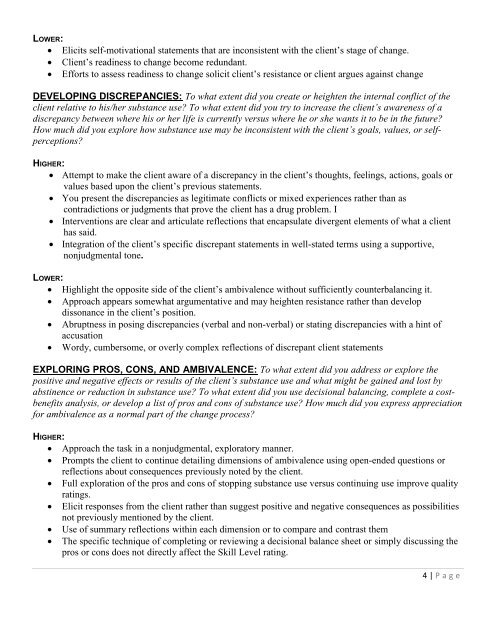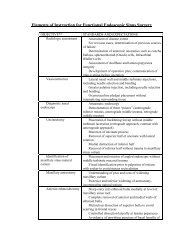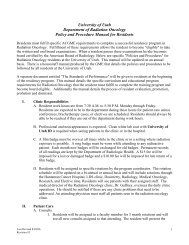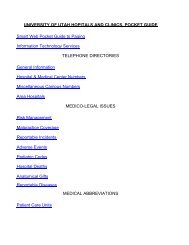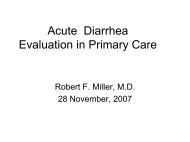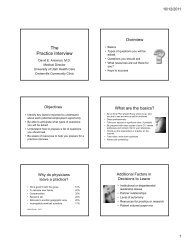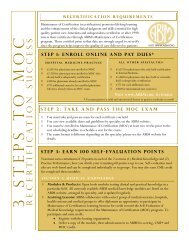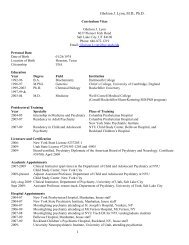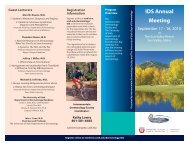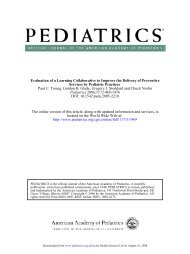Motivational Interviewing Ratings: Higher and Lower Skill Levels
Motivational Interviewing Ratings: Higher and Lower Skill Levels
Motivational Interviewing Ratings: Higher and Lower Skill Levels
Create successful ePaper yourself
Turn your PDF publications into a flip-book with our unique Google optimized e-Paper software.
LOWER:<br />
Elicits self-motivational statements that are inconsistent with the client’s stage of change.<br />
Client’s readiness to change become redundant.<br />
Efforts to assess readiness to change solicit client’s resistance or client argues against change<br />
DEVELOPING DISCREPANCIES: To what extent did you create or heighten the internal conflict of the<br />
client relative to his/her substance use? To what extent did you try to increase the client’s awareness of a<br />
discrepancy between where his or her life is currently versus where he or she wants it to be in the future?<br />
How much did you explore how substance use may be inconsistent with the client’s goals, values, or selfperceptions?<br />
HIGHER:<br />
Attempt to make the client aware of a discrepancy in the client’s thoughts, feelings, actions, goals or<br />
values based upon the client’s previous statements.<br />
You present the discrepancies as legitimate conflicts or mixed experiences rather than as<br />
contradictions or judgments that prove the client has a drug problem. I<br />
Interventions are clear <strong>and</strong> articulate reflections that encapsulate divergent elements of what a client<br />
has said.<br />
Integration of the client’s specific discrepant statements in well-stated terms using a supportive,<br />
nonjudgmental tone.<br />
LOWER:<br />
Highlight the opposite side of the client’s ambivalence without sufficiently counterbalancing it.<br />
Approach appears somewhat argumentative <strong>and</strong> may heighten resistance rather than develop<br />
dissonance in the client’s position.<br />
Abruptness in posing discrepancies (verbal <strong>and</strong> non-verbal) or stating discrepancies with a hint of<br />
accusation<br />
Wordy, cumbersome, or overly complex reflections of discrepant client statements<br />
EXPLORING PROS, CONS, AND AMBIVALENCE: To what extent did you address or explore the<br />
positive <strong>and</strong> negative effects or results of the client’s substance use <strong>and</strong> what might be gained <strong>and</strong> lost by<br />
abstinence or reduction in substance use? To what extent did you use decisional balancing, complete a costbenefits<br />
analysis, or develop a list of pros <strong>and</strong> cons of substance use? How much did you express appreciation<br />
for ambivalence as a normal part of the change process?<br />
HIGHER:<br />
Approach the task in a nonjudgmental, exploratory manner.<br />
Prompts the client to continue detailing dimensions of ambivalence using open-ended questions or<br />
reflections about consequences previously noted by the client.<br />
Full exploration of the pros <strong>and</strong> cons of stopping substance use versus continuing use improve quality<br />
ratings.<br />
Elicit responses from the client rather than suggest positive <strong>and</strong> negative consequences as possibilities<br />
not previously mentioned by the client.<br />
Use of summary reflections within each dimension or to compare <strong>and</strong> contrast them<br />
The specific technique of completing or reviewing a decisional balance sheet or simply discussing the<br />
pros or cons does not directly affect the <strong>Skill</strong> Level rating.<br />
4 | P a g e


